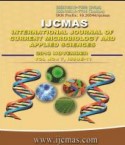


 National Academy of Agricultural Sciences (NAAS)
National Academy of Agricultural Sciences (NAAS)

|
PRINT ISSN : 2319-7692
Online ISSN : 2319-7706 Issues : 12 per year Publisher : Excellent Publishers Email : editorijcmas@gmail.com / submit@ijcmas.com Editor-in-chief: Dr.M.Prakash Index Copernicus ICV 2018: 95.39 NAAS RATING 2020: 5.38 |
Soybean is a rainy season crop but is highly sensitive to excess moisture conditions. The excess moisture or water logging conditions during monsoon season create unfavourable conditions for growth, such as reduced porosity which in turn reduces soil aeration, reduced root growth, hampered nodulation, reduced nutrient uptake affecting the physiology and biochemistry of a plant adversely which ultimately reflects on its productivity. Varieties and land configuration techniques are the two major factors for enhancing soybean yield. The present study was thus planned to analyse the effect of soybean varieties under different land configurations in mollisols of Himalayan tarai on soil moisture status. The experiment was conducted during the kharif season of 2017, in C5 block of N.E. Borlaug Crop Research Centre of G.B. Pant University of Agriculture and Technology, Pantnagar (Uttarakhand). Treatments consisted of three land configurations (Flat bed, ridge and furrow and raised bed) and varieties (PS-1092, PS-1225 and PS-1347) were set out in split plot design keeping land configurations in main plot and varieties in sub plot with three replication. After heavy rain fall, the moisture content was more in top soil layer than lower layer irrespective of the treatments. The mean value was higher by 11.5% in 0-15cm layer (14.6%) than 15-30 cm layer (13.1%). Among land configurations, flat bed recorded the highest moisture content in both the layers followed by ridge & furrow method and raised bed method. During dry spells, the mean moisture content in top layer was 10.3% and in second layer 10.1%. In top layer it ranged from 9.8% in raised bed method to 10.7% in flat bed method. Varieties failed to bring substantial impact on soil moisture content in both the layers, neither after rainfall nor during dry spells. The study revealed the importance of land configuration in maintaining positive soil moisture status.
 |
 |
 |
 |
 |